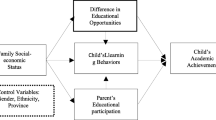Abstract
Data from the nationally representative 1994 Inter-Censal Demographic Survey are used to examine the association between family size and children s schooling in Vietnam. The data provide information on several education measures for all children over age 10, including children no longer residing in the household. Although a clear inverse bivariate association between family size and children s school attendance and educational attainment is evident, multivariate analysis controlling for urban/rural residence, region, parents’ education, household wealth, and child’s age, reveals that much of this association, especially that predicting educational attainment, is attributable to these other influences. Moreover, much of the effect that remains after statistical adjustment for the other influences is seen mainly at the largest family sizes. We consider the implications of these findings for current population policy in Vietnam and the possible features of the Vietnamese context that might account for the modest association.
Similar content being viewed by others
References
Anh, T.S., J. Knodel, L. Huong, and T.T.T. Thuy. 1995. “Education in Vietnam: Trends and Differentials.” Research report 96–359, Population Studies Center, University of Michigan.
Blake, J. 1989. Family Size and Achievement. Berkeley: University of California Press.
Bray, M. 1996. Counting the Full Cost: Parental and Community Financing of Education in East Asia. Washington, DC: World Bank.
Communist Party of Vietnam, Central Committee. 1993. Resolution on Population and Family Planning (adopted at the 4th meeting of the Party Central Committee, 7th session). Mimeographed unofficial translation.
Desai, S. 1993. “The Impact of Family Size on Children’s Nutritional Status: Insights from a Comparative Perspective.” Pp. 155–91 in Fertility, Family Size and Structure: Consequences for Families and Children, edited by C. Lloyd. New York: Population Council.
General Statistical Office (GSO), Vietnam. 1995. Inter-Censal Demographic Survey 1994: Major Findings. Hanoi: Statistical Publishing House.
Goodkind, D. 1995a. “Vietnam’s One-or-Two Child Policy in Action.” Population and Development Review 21:85–109.
—. 1995b. “Rising Gender Inequality in Vietnam since Reunification.” Pacific Affairs 68:342–59.
Haughton, J. and D. Haughton. 1995. “Son Preference in Vietnam.” Studies in Family Planning 26(6):325–37.
Hirschman, C. and V.M. Loi. 1996. “Family and Household Structure in Vietnam: Some Glimpses from a Recent Survey.” Pacific Affairs 69:229–49.
Jones, G. 1971. “Effect of Population Change on the Attainment of Educational Goals in the Developing Countries.” Pp. 315–67 in Rapid Population Growth: Consequences and Policy Implications, edited by R. Revelle. Baltimore: The John Hopkins Press.
King, E. 1987. “The Effect of Family Size on Family Welfare.” Pp. 373–411 in Population Growth and Economic Development: Issues and Evidence, edited by D.G. Johnson and R. Lee. Madison, WI: University of Wisconsin Press.
Knodel, J., P.T. Anh, and D.X. Vinh. 1995. “Vietnam’s Population and Family Planning Program as Viewed by Its Implementers.” South and East Asia Regional Working Papers (2). New York: The Population Council.
Knodel, J., N. Havanon, and W. Sittitrai. 1990. “Family Size and the Education of Children in the Context of Rapid Fertility Decline.” Population and Development Review 16:31–62.
Knodel, J. and G. Jones. 1996. “Post Cairo Population Policy: Does Promoting Girls Schooling Miss the Mark?” Population and Development Review 22:683–702.
Knodel, J. and M. Wongsith. 1991. “Family Size and Children’s Education in Thailand: Evidence From a National Sample.” Demography 28: 119–31.
Lloyd, C. 1993a. “Introduction.” Pp. 1–9 in Fertility, Family Size and Structure: Consequences for Families and Children, edited by C. Lloyd. New York: The Population Council.
—. (Ed.). 1993b. Fertility, Family Size and Structure: Consequences for Families and Children. New York: The Population Council.
—. 1994. “Investing in the Next Generation: The Implications of High Fertility at the Level of the Family.” Pp. 181–202 in Population and Development: Old Debates, New Conclusions, edited by R. Cassen. New Brunswick, NJ: Transaction Publishers. (See also expanded version issued as Research Division Working Papers, No. 63, 1994. New York: The Population Council.)
Mueller, E. 1984. “Income, Aspirations, and Fertility in Rural Areas of Less Developed Countries.” Pp. 121–50 in Rural Development and Human Fertility, edited by W. Schutjer and C.S. Stokes. New York: Macmillan Publishing Company.
Muoi, D. 1993. “Fostering, Educating and Promoting Human Factors for a Prosperous Population, a Powerful Country and an Enlightened Society.” Communist Journal 39(2):7–15.
National Committee for Population and Family Planning (NCPFP). 1992. Strategy for Information-Education-Communication of Population and Family Planning (1992–2000). Hanoi: NCPFP.
—. 1993. Population and Family Planning Strategy to the Year 2000. Hanoi: NCPFP.
Phai, N.V., J. Knodel, M.V. Cam, and H. Xuyen. 1996. “Fertility and Family Planning in Vietnam: Evidence From the 1994 Inter-Censal Demographic Survey.” Studies in Family Planning 27:1–17.
Polit, D. 1982. Effects of Family Size: A Critical Review of Literature Since 1973. Final Report. Washington, DC: American Institutes for Research.
Shreeniwas, S. 1993. “Family Size, Structure and Children’s Education: Ethnic Differentials Over Time in Peninsular Malaysia.” Pp. 331–72 in Fertility, Family Size and Structure: Consequences for Families and Children, edited by C. Lloyd. New York: The Population Council.
Terhune, K. 1974. A Review of the Actual and Expected Consequences of Family Size. Washington, DC: U.S. Government Printing Office.
UNESCO, Principal Regional Office for Asia and the Pacific. 1991. National Studies: Vietnam. Bangkok: UNESCO (Asia-Pacific Program of Education for All).
White, H. 1980. “A Heteroskedasticity-Consistent Covariance Matrix Estimator and a Direct Test for Heteroskedasticity.” Econometrica 48:817–30.
World Bank. 1995. Viet Nam Poverty Assessment and Strategy. Country Operations Division, Country Department I, East Asia and Pacific Region. Washington, DC: World Bank.
Author information
Authors and Affiliations
Additional information
Prepared for presentation at the annual meeting of the Population Association of America, New Orleans, May 1996. This research was supported by NIH Grant 043 TW/H000657 from the Fogarty International Center and NICHD to the Population Studies Center of the University of Michigan, “Determinants of Fertility Preferences in Southeast Asia.” Earlier assistance from the United Nations Population Fund Project VIE/93/03 facilitated this research.
Rights and permissions
About this article
Cite this article
Anh, T.S., Knodel, J., Lam, D. et al. Family size and children’s education in Vietnam. Demography 35, 57–70 (1998). https://doi.org/10.2307/3004027
Issue Date:
DOI: https://doi.org/10.2307/3004027




